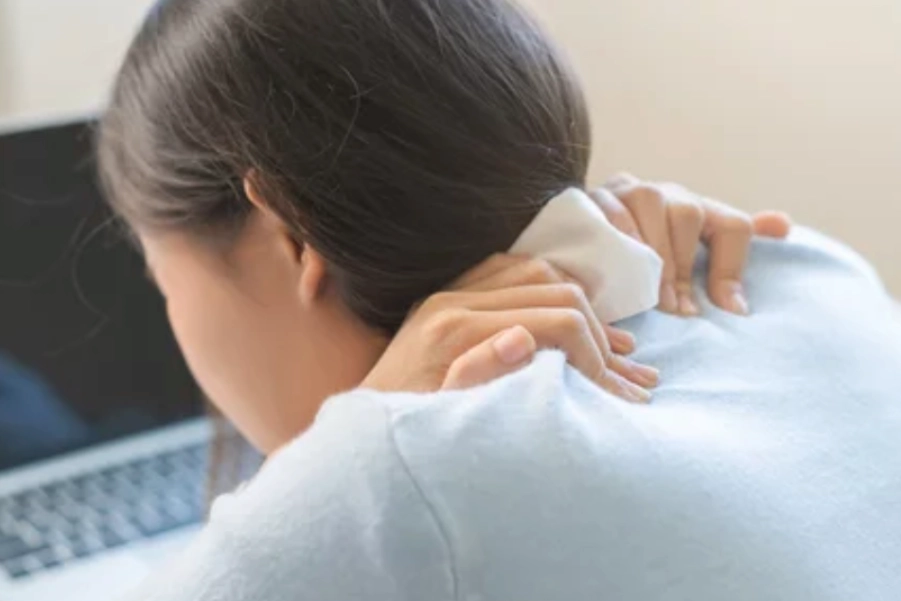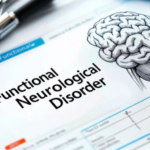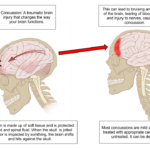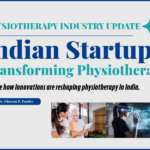Overview of Conditions:
Acute mechanical neck pain is characterized by sudden discomfort and stiffness in the cervical region, typically resulting from musculoskeletal injuries such as muscle strains, ligament sprains, or joint dysfunction. It often follows activities that involve sudden movements, poor posture, or repetitive strain (such as prolonged sitting or using mobile devices). This condition may be associated with restricted range of motion, localized pain, and muscle tightness.
Etiology and Prevalence:
Acute mechanical neck pain accounts for the majority of cervical spine-related pain, with a lifetime prevalence estimated at 70% in the general population (Adebayo et al., 2021). Though most cases resolve with conservative treatment, recurrent episodes can occur without effective intervention.
Assessment and Evaluation:
- History:
- Onset: Acute or gradual onset. Often linked to specific activities (e.g., sleeping awkwardly, sudden movement, or prolonged poor posture).
- Pain Localization: Typically localized in the neck, may radiate to shoulders or upper back.
- Previous Episodes: Inquire about any history of neck pain or previous musculoskeletal injuries.
- Activities: Examine habitual movements, posture, and ergonomics, particularly during work or recreational activities.
- Pain Assessment:
- Visual Analog Scale (VAS): For quantifying pain intensity.
- Neck Disability Index (NDI): To assess the impact of pain on daily functional activities.
- Postural and Biomechanical Assessment:
- Observation of head and neck posture (forward head posture, rounded shoulders).
- Palpate for muscle tension or trigger points (upper trapezius, levator scapulae).
- Functional limitations such as difficulty turning the head or performing daily tasks.
- Range of Motion (ROM):
- Assess active and passive cervical spine movements: flexion, extension, lateral flexion, and rotation. Note any pain or restriction.
- Strength and Palpation:
- Strength test for cervical stabilizers, including deep cervical flexors.
- Palpation for tenderness in muscles and ligaments (e.g., upper trapezius, levator scapulae, suboccipital region).
- Special Tests:
- Spurling’s Test: To assess for nerve root involvement.
- Cervical Compression/Distraction Tests: To evaluate joint involvement and assess for neurological compression.
Goal Setting:
Short-Term Goals:
- Reduce pain and muscle spasm.
- Restore cervical range of motion (ROM).
- Decrease muscle tightness and improve posture.
- Educate the patient on posture correction and ergonomics.
Long-Term Goals:
- Prevent recurrence of neck pain.
- Restore full cervical mobility.
- Strengthen the cervical stabilizing muscles to support proper posture and reduce strain.
- Provide education on long-term self-management techniques.
Recommended Treatment:
Electrotherapy:
- Transcutaneous Electrical Nerve Stimulation (TENS):
- Indication: Pain relief and reduction of muscle spasm.
- Parameters: Frequency: 80-120 Hz for acute pain relief. Intensity: Comfortable intensity, as tolerated by the patient. Pulse width: 100-300 µs. Duration: 15-20 minutes, up to three times per day.
- Mechanism: TENS works by stimulating sensory nerves to modulate pain signals through the Gate Control Theory and releasing endorphins.
- Interferential Therapy (IFT):
- Indication: Deep tissue pain relief, reduction of inflammation, and muscle relaxation.
- Parameters: Frequency: 4,000 Hz (carrier), modulated at 100 Hz for muscle relaxation. Duration: 20-30 minutes.
- Mechanism: IFT is a low-frequency electrical stimulation used to alleviate deep-seated pain by enhancing circulation, reducing muscle spasm, and promoting tissue healing.
- Class 4 LASER Therapy:
- Indication: Reduce inflammation and pain, promote tissue healing.
- Parameters: Wavelength: 800-900 nm. Power: 5-10 W. Duration: 3-5 minutes per treatment area.
- Mechanism: Class 4 LASER promotes cellular regeneration, increases collagen synthesis, and enhances circulation, speeding up the healing process of affected tissues.
- Ultrasound Therapy:
- Indication: Deep heating for muscle relaxation and reduction of stiffness.
- Parameters: Frequency: 1 MHz (for deeper tissue penetration). Intensity: 0.5-1 W/cm². Duration: 5-10 minutes per treatment area.
- Mechanism: Ultrasound generates thermal effects in deeper tissues, which increases circulation, reduces muscle tension, and promotes healing in the affected region.
Thermotherapy:
- Moist Heat Packs:
- Indication: To reduce muscle tightness and promote relaxation.
- Application: Apply heat for 15-20 minutes over the cervical region.
- Mechanism: Heat promotes vasodilation, increases blood flow, reduces muscle stiffness, and decreases pain perception by stimulating sensory nerves.
Manual Therapy:
- Myofascial Release:
- Indication: Release muscle tension, particularly in the upper trapezius and levator scapulae.
- Technique: Apply sustained pressure to tender or tight muscle areas, gently stretching fascia and releasing tension.
- Mechanism: Myofascial release works by relaxing the soft tissue, increasing blood flow, and breaking down muscle adhesions.
- Muscle Energy Techniques (MET):
- Indication: For restoring ROM and alleviating muscle spasms.
- Technique: Instruct the patient to contract the affected muscle group against a gentle resistance, followed by passive stretching.
- Mechanism: MET uses the principle of autogenic inhibition to relax muscle spasm and elongate muscles.
Exercise Therapy:
- Gentle Stretching:
- Perform gentle neck stretches, such as cervical flexion/extension, side bending, and rotation stretches.
- Duration: Hold each stretch for 15-30 seconds, repeating 3 times.
- Isometric Strengthening Exercises:
- Exercise Examples: Perform isometric exercises for cervical flexors, extensors, and lateral flexors (hold for 5-10 seconds).
- Reps: 10-15 reps per muscle group, 2-3 sets.
- Postural Correction:
- Exercise: Educate on maintaining neutral cervical spine alignment during sitting, standing, and working.
- Ergonomic Education: Emphasize the importance of proper workstation setup (e.g., screen at eye level, support for the neck).
Precautions:
- Electrotherapy:
- Avoid using electrotherapy in patients with pacemakers, implanted defibrillators, or other electrical implants.
- TENS intensity should not cause discomfort or skin irritation.
- Thermotherapy:
- Do not use heat if the area is inflamed or if there is a risk of open wounds.
- Avoid prolonged heat exposure to prevent burns.
- Manual Therapy:
- Avoid high-velocity thrusts or manipulations in the acute phase or in the presence of neurological symptoms or signs of disc herniation.
- Use gentle techniques to avoid exacerbating pain.
- Exercise Therapy:
- Avoid strenuous or high-impact exercises during the acute phase.
- Ensure exercises are pain-free and performed with proper technique.
Reassessment and Criteria for Progression/Change in Care Plan:
- Pain and Functional Improvement:
- A reduction of at least 2-3 points on the VAS scale after 1-2 weeks of treatment.
- Improvement in ROM, with less pain and increased mobility.
- Strength and Posture:
- After 3-4 weeks, reassess muscle strength, particularly the cervical stabilizers and postural muscles.
- Improvement in posture, with reduced forward head posture and a more neutral cervical curve.
- Criteria for Progression:
- If pain is significantly reduced and ROM is restored, transition to strengthening exercises for the cervical stabilizers and posture correction.
- Gradually reduce the frequency of electrotherapy and increase the intensity of therapeutic exercises.
References:
- Adebayo, M., et al. (2021). Management of acute mechanical neck pain: A review of current evidence. Journal of Pain Research, 14, 1211-1220. DOI: 10.2147/JPR.S303496
- Furlan, A. D., et al. (2021). Interventions for acute musculoskeletal pain: A systematic review. Journal of Pain, 22(7), 730-747. DOI: 10.1016/j.jpain.2021.02.016
- Chow, R. T., et al. (2021). Class 4 laser therapy for musculoskeletal pain management: A meta-analysis. Lasers in Surgery and Medicine, 53(5), 728-738. DOI: 10.1002/lsm.23204
Disclaimer:
This content is provided for informational purposes only. It is important to consult with a qualified healthcare provider for an accurate diagnosis and personalized treatment plan.
Note:
Treatment options should be chosen wisely and appropriately. For example, where multiple options are recommended, any one option can be selected based on availability and appropriateness, such as in electrotherapy.






